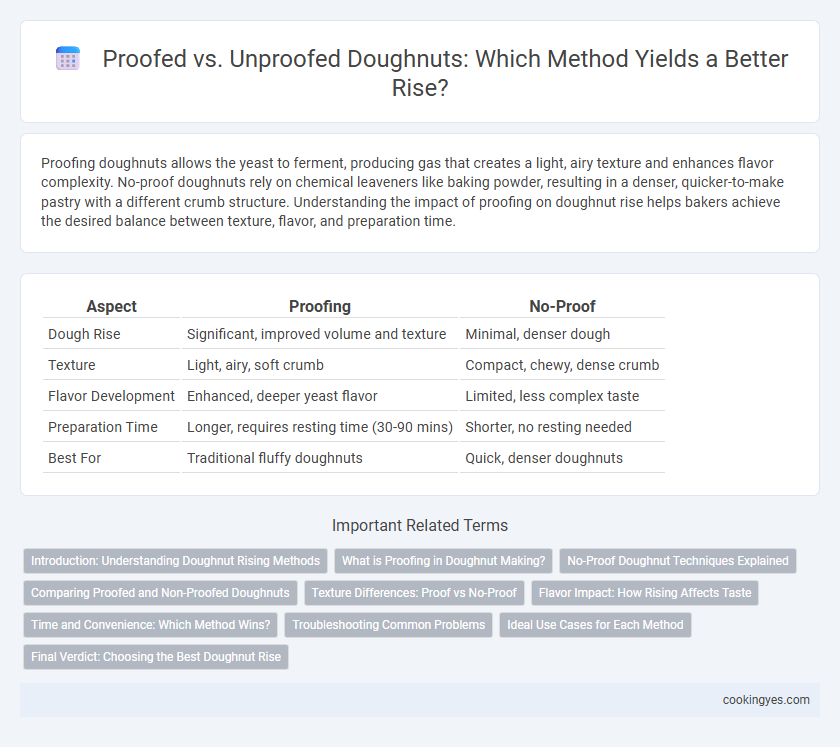Proofing doughnuts allows the yeast to ferment, producing gas that creates a light, airy texture and enhances flavor complexity. No-proof doughnuts rely on chemical leaveners like baking powder, resulting in a denser, quicker-to-make pastry with a different crumb structure. Understanding the impact of proofing on doughnut rise helps bakers achieve the desired balance between texture, flavor, and preparation time.
Table of Comparison
| Aspect | Proofing | No-Proof |
|---|---|---|
| Dough Rise | Significant, improved volume and texture | Minimal, denser dough |
| Texture | Light, airy, soft crumb | Compact, chewy, dense crumb |
| Flavor Development | Enhanced, deeper yeast flavor | Limited, less complex taste |
| Preparation Time | Longer, requires resting time (30-90 mins) | Shorter, no resting needed |
| Best For | Traditional fluffy doughnuts | Quick, denser doughnuts |
Introduction: Understanding Doughnut Rising Methods
Proofing doughnuts involves allowing the dough to rest and ferment, activating yeast to produce carbon dioxide, which creates a light and airy texture. No-proof doughnuts skip this fermentation step, relying on chemical leaveners like baking powder to achieve rise, resulting in a denser but quicker-to-make product. Understanding the differences in these rising methods is crucial for selecting the desired texture and preparation time in doughnut recipes.
What is Proofing in Doughnut Making?
Proofing in doughnut making is the process where the dough is allowed to rest and rise before cooking, enabling yeast fermentation to produce carbon dioxide that creates light, airy texture. Without proofing, doughnuts tend to be denser and less fluffy because the yeast has less time to develop gas bubbles. Proper proofing time varies but typically ranges from 30 minutes to a few hours, depending on dough temperature and yeast activity.
No-Proof Doughnut Techniques Explained
No-proof doughnut techniques rely on chemical leaveners like baking powder or baking soda instead of yeast fermentation to achieve rise, significantly reducing preparation time while maintaining a light, airy texture. These methods often use whipped egg whites or baking powder paste to create steam and air pockets, ensuring a tender crumb without the extended proofing period. No-proof doughnuts suit busy kitchens and experimental recipes by simplifying the process and offering consistent, fluffy results without yeast's unpredictability.
Comparing Proofed and Non-Proofed Doughnuts
Proofed doughnuts develop a lighter, fluffier texture due to the yeast fermentation allowing the dough to rise and create air pockets, resulting in a tender crumb. Non-proofed doughnuts tend to be denser and more compact since the dough lacks the time to ferment and expand before frying. Proofing improves overall volume and softness, while skipping proofing produces a chewier texture with less rise.
Texture Differences: Proof vs No-Proof
Proofed doughnuts develop a lighter, airier texture due to yeast fermentation producing carbon dioxide, which creates bubbles that expand during frying. No-proof doughnuts tend to be denser and chewier, as they lack the extended fermentation time that allows gluten to relax and gases to form. The proofing process significantly influences crumb structure, resulting in a softer and more tender doughnut compared to the compact texture of no-proof varieties.
Flavor Impact: How Rising Affects Taste
Proofing doughnuts through yeast fermentation enhances flavor complexity by allowing organic acids and alcohols to develop, resulting in a richer, tangier taste profile compared to no-proof doughnuts. No-proof doughnuts often rely on chemical leavening agents, producing a sweeter but less nuanced flavor, as the lack of fermentation limits the depth of taste. The proofing process also contributes to a lighter texture, which amplifies the overall eating experience and flavor perception.
Time and Convenience: Which Method Wins?
Proofing doughnuts involves allowing the dough to rise, typically taking 1 to 2 hours, which enhances texture and flavor but requires advance planning. No-proof doughnuts skip this step, cutting preparation time by over an hour and providing a quicker, more convenient option for immediate frying. Convenience-focused bakers often prefer no-proof for faster results, while traditionalists favor proofing for superior rise and crumb structure.
Troubleshooting Common Problems
Insufficient proofing in doughnut preparation often results in dense, heavy texture due to inadequate yeast activity, whereas no-proof methods may lead to uneven or flat doughnuts lacking proper rise and fluffiness. Troubleshooting common issues includes ensuring optimal proofing times at controlled temperatures to activate yeast fully, preventing under or over-proofing that can cause dough collapse or off-flavors. Adjusting hydration levels and using fresh yeast or proper chemical leaveners can also resolve problems related to doughnut rise, achieving consistent, airy results.
Ideal Use Cases for Each Method
Proofing doughnut dough allows fermentation to develop flavor and a light, airy texture, making it ideal for traditional yeast doughnuts and artisan recipes. No-proof methods suit quick, cake-style doughnuts where immediate frying is desired, providing a denser texture and faster preparation time. Selecting proofed dough is best for complex flavors and soft crumb, while no-proof methods excel in convenience and consistent volume for mass production.
Final Verdict: Choosing the Best Doughnut Rise
Proofing doughnut dough allows yeast fermentation to develop gluten structure and gas bubbles, resulting in a lighter, airier texture and enhanced flavor depth. No-proof doughnuts rely on chemical leaveners like baking powder, providing a quicker rise but a denser, cake-like crumb and less complex taste. For optimal doughnut rise, proofed dough yields superior texture and flavor, making it the preferred choice for artisanal quality.
Proofing vs No-proof for doughnut rise Infographic

 cookingyes.com
cookingyes.com